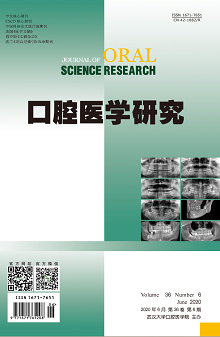|
|
Adhesion, Proliferation, and Osteogenic Differentiation of hSCAPs on HAP and PDA-HAP
HE Lin, HE Song, WU Xi, YANG Sen
2020, 36(6):
523-527.
DOI: 10.13701/j.cnki.kqyxyj.2020.06.006
Objective: To compare cell adhesion, proliferation, and osteogenic differentiation of hSCAPs on the HAP and PDA-HAP scaffolds. Methods: hSCAPs were extracted by improved tissue block method and cell surface antigens, i.e. STRO-1, CD90, CD146, CD45, and CD34, were identified by flow cytometry. hSCAPs were inoculated on HAP and PDA-HAP, respectively. DAPI and rhodamine phalloidin were used to stain the nucleus and cytoskeleton respectively to observe cell morphology. The cell proliferation was measured by CCK8 after 1, 3, 5, and 7 days. ALP activity and expression of ALP, OCN, and Runx2 were detected after 1, 7, and 14 days. Results: The hSCAPs expressed STRO-1 (+), CD90 (+), CD146 (+), CD45 (-), and CD34 (-). The number of hSCAPs attached to PDA-HAP was more than that on HAP (P<0.001), and the cell area on PDA-HAP was larger and more fully extended than that on HAP. There was no significant difference in toxicity between HAP and P DA-HAP when cultured hSCAPs for 1, 3, 5, and 7 days (P>0.05). There was no significant difference on the ALP activity between two groups on the 1st and 14th day of induction (P>0.05), however, significant difference on the 7th day (P<0.001). By real-time PCR, it was found that the expression of ALP was the same as that of ALP activity; the expressions of Runx2 in PDA-HAP group were higher than those in HAP group on 1, 7, and 14 days (P<0.05); there was no significant difference on the expression of OCN between two groups on the 1st day (P>0.05), however, significant difference on the 7th and 14th day (P< 0.05). Conclusion: PDA-HAP can significantly promote the expression of ALP, Runx2, and OCN, and promote the osteogenic differentiation of hSCAPs.
References |
Related Articles |
Metrics
|

